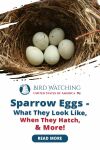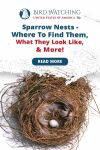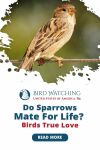
What’s This Post About?
House Sparrows are among the most ubiquitous birds living across cities, towns, suburbs, and farms. Simply put, these birds are likely to be found anywhere near humans.
You might find yourself feeling fond of the tiny species’ incessant chirping, or it might be a nuisance bird that tries to invade your space to establish its nest on your property.
House Sparrows build their nests close to where there is human traffic. They not only find abundant food supply and shelter but these tiny, enlivened species enjoy themselves a great deal in such environments.
Though they might not be among the favorites of the birders, due to their invasive and fierce habits, they cannot be eliminated from the environment.
The sparrow’s eggs are meager in size just like the tiny size of the bird itself. Usually white, the female lays a clutch of around 4-5 eggs. Tiny nestlings sprout out of the eggs after incubating for 10 to 16 days. Quite limp when born, they grow up into independent sparrows within five weeks.

Read this post to learn about various attributes of the sparrow eggs to make their identification simpler.
What do Sparrow Eggs look like?
Concurrent to the tiny size of the birds, sparrow eggs are also quite small, measuring approximately 22.5 mm in length and 15.5 mm in width, having a sub-elliptical shape, having an average mass of 2.9 grams.
It’s not always easy to identify the eggs of other birds. However, if you’re looking at the eggs of the sparrow, it is quite simple to identify them due to their rather meager size.
Having a glossy texture, the eggs are primarily white, sometimes slightly tinging towards blue or green. The eggs often have dense brown or blueish greyish speckles. Sometimes, these might look like prominent brown or grey spots on the shells of the egg.

How Many Eggs Do Sparrows Lay?
House Sparrows lay clutches comprising of 3 to 6 eggs though the clutch size can vary from anywhere between 1 to 8 eggs.
Sparrows are known to raise multiple broods all year round. During the breeding season, which typically lasts from April till August, the pairs might breed multiple times, producing two to three clutches, and sometimes, even make a successful fourth attempt.
The number of eggs laid by a sparrow depends on several factors. The season of the location, the female’s age, breeding density, and the environment all can affect the size of the clutch.
For example, sparrows living in higher regions are likely to lay a smaller clutch due to the cold weather.

Did You Know?
Sparrow eggs may vary in size among themselves, with noticeable differences in their size. Usually, the eggs laid later in the clutch are larger and can also be hereditary.
Understanding & Spotting Sparrow Eggs
To understand and be able to spot eggs of sparrows easily, here’s a table to make the process easier for you with a couple of easy-to-remember points.
| Clutch Size | Minimum – 1 Maximum – 10 Average – 4,5 |
| Number of Broods | 1 to 4 |
| Breeding Season | March till August |
| Egg size | 2.2 x 1.5 cm |
| Incubation period | 10-14 days |
| Nestling Period | 15- 20 days |
| Egg Appearance | Usually white, sometimes tinging towards blue or green with brown speckles |
| Nestlings at birth | Naked with bright pink skin, quite limp and helpless, closed eyes |
Why Are the Eggs Different in Size?
The slight variation in the size of the eggs can sometimes make the identification of eggs challenging. The difference in the volume of the smallest and the largest sparrow egg has been found to be around 50 percent.
Generally, the sparrows that hatch from the bigger eggs are relatively bigger. Larger eggs provide the nestlings with additional reserves of energy, which means that these eggs are better in terms of the survival rate of newborn chicks.
Since the parent sparrows have to leave their nests in search of food sometimes, the sizable egg is better able to provide energy and warmth to the little one inside. These extra reserves of energy play a vital role in lower temperatures when the hatchling needs additional warmth to survive.

Did You Know?
Generally, the eggs decrease slightly in size from laying to hatching period.
The young sparrows that hatch from relatively tiny eggs have a better chance of survival in relatively warmer temperatures.
Sometimes in the warmer temperatures, larger eggs comprising of extra reserves help in the survival of the bird in the longer run, resulting from faster growth. This might cause the young one to grow at a quicker rate.
Remember, this is not always a healthy sign!
If the egg comprises of high levels of reserves combined with a large content of food along with higher temperatures, the young sparrow might grow too fast – hence, resulting in a lower rate of survival.

To understand why this happens let’s take a look at the biological phenomenon of oxidative stress that affects the growth of the species.
The fast growth of the bird results in a rise in the reactive oxygen species. During the time of the species growing at an unusually rapid pace, the defense mechanism of the body is not able to put up with compounds, eventually, being unable to keep up with the fast rate.
The resulting pressure on the organism’s body causes the formation of shorter telomeres. According to biologists, the length of the telomere is directly related to the length of lives of the animal. Smaller telomeres thereby reduce the lifespan of the bird.

What Are Telomeres?
They are a genetic feature. They appear like caps at the end of the DNA strands. These specialized proteins at the end of the chromosomes help to protect the genes from being distorted when the division of cells takes place.
To deal with this issue, sparrows lay different sizes of eggs in the same clutch.
Since they are unable to predict the climatic conditions to make sure that the young are adeptly fit for their survival in the environment, the variation in sizes of the eggs helps elevate the probability of survival of some, if not all, the eggs.

House Sparrow Nesting
Preferring to live in exquisite environments filled with activity, house sparrows build their nests anywhere near the human population. Keep reading to find out interesting facts about the nests of these robust species.
Where Do House Sparrows Nest?
Sparrows are not a rare sight in the urban and suburban regions. From dawn to dusk, you can easily spot the little creatures chirping around, hopping on the ground, and foraging the plants.
One of the most frequent visitors to your yard, they’ll stop by frequently to have a meal or simply to perch on the trees.
These city-dwelling birds prefer to have their habitats close to where the humans live. These areas provide the birds easy access to food and provide them with protection and shelter for nesting.
You can find sparrow nests not only in the trees or birdhouses but also in building rooftops, outdoor lighting fixtures, kitchen vents, gutters, and any other crevices around humans. After all, these little beings like to stay around near bustling areas with some action.

Though tiny in size, sparrows are pretty active and robust species that seem to be fluttering around. Once they build their nests, the sparrows use them all around the year.
So, if you have a sparrow nest outside your window or kitchen vent, be prepared to observe incessant chirping and activity all year round. In fact, they can sometimes penetrate into houses or other buildings through any openings.
Sparrows breed in the summer and spring seasons. During this time, they will use their nests to raise the young ones. These rapidly multiplying birds can breed and raise as many as four broods during the breeding season in this one nest.
After the season is over, for the rest of the year, the sparrows rest and roost in their nest at night.

What Do Sparrow Nests Look Like?
Generally, sparrows begin to build their nests between February and May, right before the breeding season. The sparrows build their nests using any trash or debris they can collect, usually dried coarse in texture.
Nesting Materials such as dried vegetation, feathers, string, hair, and grass are used to make the structure of the nest. The bird finds small holes and stuffs the nesting items in the hole of the structure until it is almost full, providing a firm base for the nest.
The bird then uses finer material such as feathers, grass, strings, and paper for the inner lining.

Did You Know?
House sparrows are sociable species that often build their nests close to each other. Sometimes they might even share the walls of the nests, forming them next to one another.
If need be, sparrows strongly compete with other native birds for their desired nesting sites. These fierce competitors might even chase away birds like the Tree Swallows and bluebirds to attain the nest boxes that were intended for them.
Fun Fact
If any day, you are seeing very few birds at your bird feeder, there is a strong likelihood that house sparrows have excelled in scaring the birds away.
What Do House Sparrow’s Nests Look Like?
Built with dried leaves, grass, and twigs as well various other forms of trash, when completed, the house sparrow’s nest looks like a perfect sphere, measuring around 8 to 10 inches in diameter.
If you get a chance to closely observe the nest of the tiny species, you’ll note how cluttered and unkempt the little shelter is. What’s even more surprising is that the sparrows don’t mind the messy place and aren’t too bothered by it.

Did You Know?
Sparrows may not just build one but several nests for themselves. Sometimes, the predators might steal their eggs when the sparrows are away or the sparrows themselves abandon the nests to build a better one.
Mating and Breeding
Like most birds, the fundamental purpose of these twittering birds is to mate and propagate their breed. By producing offspring, they can expand their genes. And luckily, for sparrows, they are quite successful at it as they can produce multiple breeds in a single year!
But before sparrows lay their eggs that hatch to produce tiny babies, they need to select a pair to mate with. Let’s take a look at how the sparrows attract each other.

How Do the House Sparrows Choose Their Mate?
House sparrows are monogamous, faithful species that usually mate for life. They might only choose another partner if their mate dies.
Did You Know?
There are instances when the birds may depict promiscuous behavior, and engage in extra-pair copulations. This means that there are a few baby sparrows that have a different father from their mother's lifelong mate.
The courtship activities of the sparrows begin from January and last till July. Before finding a mate, the male house sparrow claims his nesting site, restricting any other bird to step in. If any bird tries to enter, the sparrow would aggressively fight to chase it away.
To attract the female, the male starts to chirp around the nesting site. As a female sparrow flies by, he’ll begin to chirp even louder, singing his melodious vocalizations at a rapid pace.
He displays himself to the female by moving his body up and down, twittering his wings, elevating and spreading his tail, and pushing his head up to reveal his bib to the targeted female.
To respond to this attempt of the male, the female sparrow displays a threatening posture, usually attacking the male before flying by. The male would follow her for a short distance, hopping around to entice her as it ruffles its wings.

Sometimes, other males might also join and imitate the same behavior to attract and pursue the same female. However, this ground display by the male doesn’t always instantly result in copulation. Once the female chooses her partner, she initiates the copulation by chirping a soft call to the selected mate.
The birds form a pair and finally mate together, with the male mounting the female near the nest site. After this, they would engage in the process of nesting.
The mating ritual of the sparrows occurs throughout the breeding season, beginning from March till August. Sometimes, it may even occur several times in a day, after which the birds lay their eggs.

How Long Does It Take for The Sparrows Eggs to Hatch?
Once the mating between the male and female sparrow takes place, the female sparrow lays the eggs. This usually happens a week after the nest is built. At the time of breeding, the sparrow lays a clutch of around 4-5 eggs at daily intervals, though this number varies and some nests can have up to 7-8 eggs.
The female starts to incubate the eggs after she has laid all the eggs. If the weather doesn’t seem suitable, the female sparrow might wait to begin incubating the eggs.
During the incubation period, which lasts for around 12 days, both the sexes take turns to sit on the egg, although the female incubates for the most time.

The newly born sparrows that hatch out of the eggs are entirely naked at the time of their birth with bright pink skin. Like most infant chicks, they are helpless and clumsy at birth, unable to open their eyes.
These chicks are brooded for 6-8 days and are only able to control their body temperature when they are at least 10 days old. Both the male and female parents of the little sparrows share the responsibility of raising their young and feeding them food.
The young sparrows fledge for almost 17 to 18 days before they are ready to leave their nests. During their initial days in the nest, they are primarily fed an array of invertebrates. Insects like caterpillars, aphids, beetles, and grasshoppers comprise the diet of the nestlings.
They are also fed seeds and vegetable content if insects are scarce, which is usually the case in winters. However, these seeds, grains, and vegetables become a major part of the young sparrow’s diet as it grows older.

Even after leaving their nests, the young sparrows are unable to feed themselves, though, by this time, they have learned to fly.
Since these young birds cannot find their own food and lack survival skills outside the nest, they need to be conscientiously looked after by their parents for almost two weeks until they become completely independent.
This post-fledging care is crucial, and in most cases, falls under the responsibility of the male. It is the prime time for sparrows to be at the pinnacle of activity, so the female sparrow prepares to produce the next breed, and so the father takes care of the fledging’s.

Did You Know?
Sparrows are able to produce at such rapid rates that the female begins laying the next clutch within a few days of her previous brood fledging and leaving the nest.
What Do the Young Sparrows Feed on?
After the young sparrows have remained under the company of their parents for about a fortnight, they are now self-subsistent to move about on their own.
Searching for sources of food, these young sparrows usually gather around in flocks, anywhere they seem to find an abundant supply of their feed such as seeds, insects, and grains. They would explore areas with waste, farmlands with crops, and garden feeding sites.
Sparrows dwelling near your house, perhaps in the crevices or creepers against the wall, or in the traffic lighting fixtures on the road might visit your yard to have a mouthful of delicacies.
To attract these energetic tiny mates to your yard, consider filling your bird feeders with their choice of food. Explore the Kaytee Wild Bird Food.
Kaytee Wild Bird Food 5lb
The seed mix is perfect for hopper feeders, platform feeders, and tube feeders
Make sure the feeder you use is immaculate for the sparrows otherwise these rigorously competing birds might end up chasing away the other visitors to your yard. It would be ideal if you could place a separate one for the sparrows to ensure these invasive birds don’t bother other birds around.
Read our post to decide on the right kind of bird feeder for your backyard.
How to Choose the Right Kind of Bird Feeder: Types, Location, Size, etc.
Are you here searching for a suitable bird feeder for your garden? Well, you're at the right place because here we will discuss various bird feeders.
The young are later joined by the adult sparrows as well once they have finished nesting. However, these large flocks of sparrows flicking around to the foraging sites tend to break up as autumn approaches and these birds return to their nesting colonies.
In most cases, the sparrows prefer to stay relatively close to their nesting sites. Choosing to restrict their movement, they stay close to home, and usually, do not even migrate.
During the nesting season, sparrows would confine themselves within a radius of 1-1.5 miles from their nests, and do not fly any further than about 5 miles from their nesting sites otherwise. This is the sparrow’s way of establishing territories.
So, if you see flocks of sparrows flying around your house, it means that these little fellows are nesting somewhere nearby. Now you’ll either be aggravated or enjoy the chirping company of these gregarious birds for a long time since they often end up using the same nests again.

Do Sparrows Abandon Their Eggs?
If you’ve recently been noticing a sparrow nest with a few eggs present, but the parent itself is absent from the picture, you can’t simply declare the nest as abandoned.
The nest may be temporarily left unattended by the bird for several possible reasons. Both the female and male sparrow may be out to grab some food. The parents have to leave the nests periodically to feed themselves.
When incubating the eggs, the sparrow might take a half an hour break. However, if incubation has not yet begun, and the sparrow is still laying eggs each day, it doesn’t really have to spend its entire time in the nest. Don’t worry, the sparrows will come back to the nest after some time.

Did You Know?
Sparrows prefer to lay all their eggs first before beginning to incubate them. This strategy is employed to make sure all the nestlings develop at the same rate and hatch together. This makes it easier for the two parents to raise their babies. Therefore, they do not need to sit on the eggs until the mother sparrow has laid all the eggs.
The sparrow eggs in the nest can be left for almost two weeks before their incubation begins. For this reason, some sparrows might deliberately stay away from the nests so that they don’t draw the attention of predators and even humans towards their nests.
Don’t worry as the sparrows are still keeping an eye on their eggs from a distance even if they aren’t physically present. Next time you see a nest with eggs without the parents present, it is quite possible the sparrows haven’t yet begun the incubation.

Sparrows are quite fierce and hostile birds that chase away any bird that tries to come near the territory of their nests.
A momentary scare can’t just threaten them to leave their nests, but if they constantly feel endangered and harassed, sensing predatory movement to raid their nests or trying to get their eggs, they would leave their nests for good to find a new nesting site.
Realizing that their nests are no longer safe for dwelling and raising their young, the sparrows would abandon these eggs of fear that they might become a target of the predators.
They wouldn’t want to waste their time and energy on hatching eggs that have a lower chance of survival. So, the birds consider it better to produce a new brood at a different, safer site.
Warning!
Don't go close to the nests of the Sparrows! Even if out of curiosity you get too close to the nest, it might disturb and stress out the bird, causing it to end up abandoning the nest, suspecting danger.
Apart from maintaining distance from the nests to make sure you do not scare the sparrows, do not remove or displace the eggs from one nest to another or even move the nest away, speculating it to be ‘abandoned’.
Sparrows and many other species of birds do not accept foreign or unknown eggs that they haven’t laid. Hatching and taking care of the young is undoubtedly an arduous job and they do not want to feed and raise an exceeding number of eggs.
Warning!
Don't ever move the nest of the sparrows - for whatever reason. Upon returning, if the birds find their nest not to be in the original position, they may not recognize and refuse to accept the new location. This means that the sparrows would not only abandon the nest but also the eggs inside it.
Parent Sparrows can recognize if any of their egg is infertile. They would remove it from the nest to make space for the others, and would therefore destroy or throw away the egg out of the nest.
Keep Reading!
One of the most rapidly reproducing birds, sparrows lay several eggs during the breeding season. Knowing what the eggs and nests look like makes the identification process much easier.
This helps birders to make sure the eggs of the tiny birds are safe, and take precautions to keep predators away from them. We wouldn’t want the parent sparrows to abandon their young.
After all, they do a terrific job incubating the eggs, and raising their young ones. It is indeed fascinating to see how the sparrows not only take their courtship faithfully, maintaining lifelong bonds with their mates, but the fierce birds perform their parenting roles equally responsibly, taking utmost care of their eggs.
If you want to learn about the eggs and nesting sites of other frequently visiting birds in your backyard, read this post about cardinals’ eggs.
Cardinal Eggs: What They Look Like, When They Hatch, & More!
From mating rituals down to egg hatching, this post has it all! Read this post for everything on Cardinal Eggs.

By David A. Swanson
Bird Watching USA
My name is David and I'm the the founder of Bird Watching USA! I started Bird Watching with My father-in-law many years ago, and I've become an addict to watching these beautiful creatures. I've learnt so much over about bird watching over the years that I want to share with the world everything I know about them!

David A. Swanson
Bird Watching USA
My name is David and I'm the the founder of Bird Watching USA! I started Bird Watching with My father-in-law many years ago, and I've become an addict to watching these beautiful creatures. I've learnt so much over about bird watching over the years that I want to share with the world everything I know about them!











